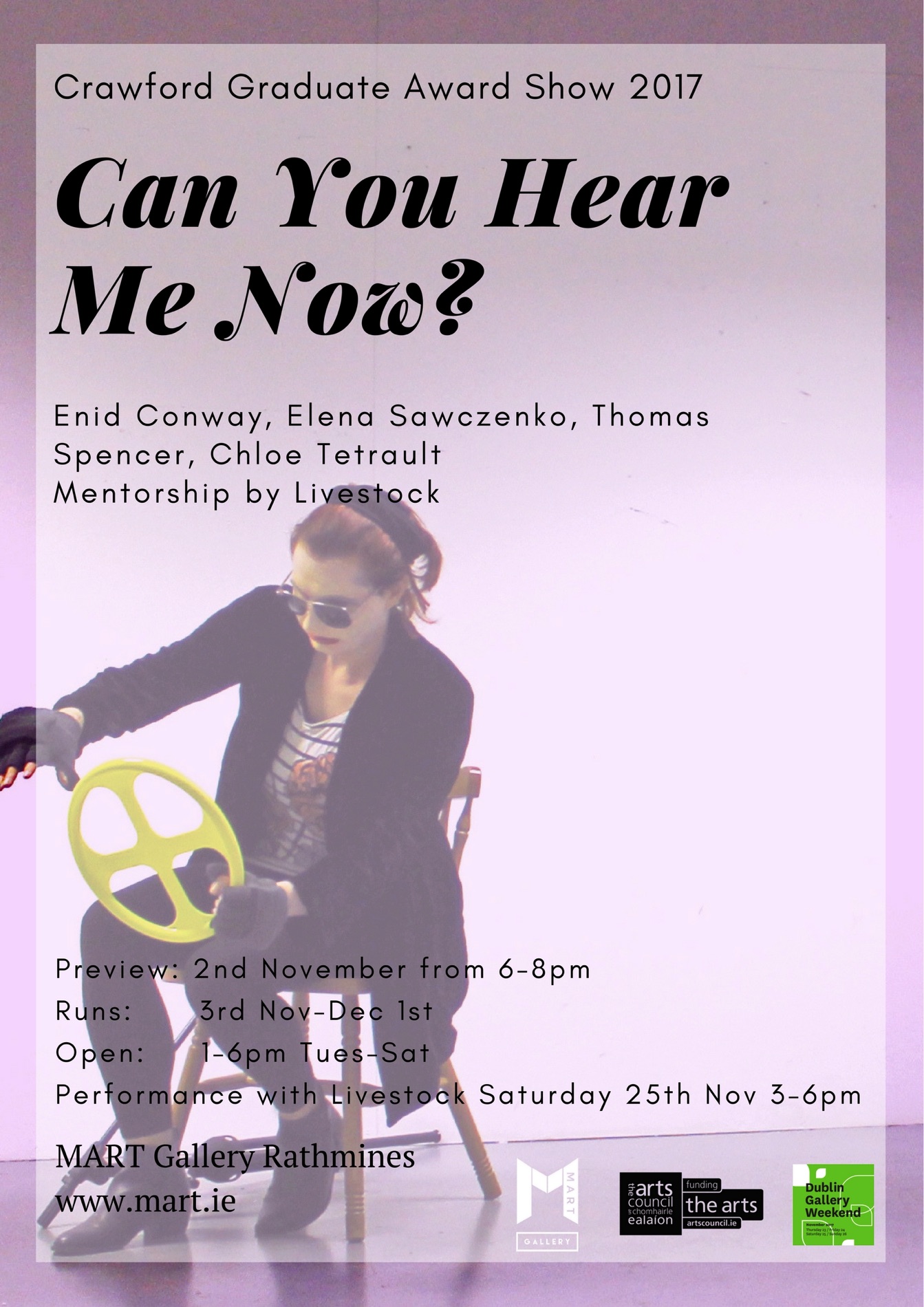MART Gallery & Studios – Providing Creative Platforms
Join our Newsletter



Artists: Enid Conway, Elena Sawczenko, Thomas Spencer, Chloe Tetrault.
Performance with Livestock for Dublin Gallery Weekend: Saturday 25 November 3-6pm.
MART presented the exhibition Can You Hear Me Now? kindly supported by Crawford College and The Arts Council of Ireland. The exhibition was presented as part of the annual Crawford Graduate Award. Mentorship by Livestock.
2 November – 1 December 2017
The MART Gallery, 190A Rathmines Rd, Lwr, Dublin 6In the inaugural year of the Crawford Graduate Award Show at MART Gallery, Can You Hear Me Now showcases Crawford College graduates working specifically in performance based practice. The exhibition unifies the work of four graduates work whose practices deal with concerns around identity, voice and the body.
Enid Conway explores how language is used by women to communicate and express themselves. Similar to games, functioning by conceptual rules known by the users, language is a construction that needs to be learned. Through a series of audio recordings of women telling mundane yet intimate stories, Conway examines the relationship between image verses word and how women express their inner worlds using this system.
Thomas Spencer utilises humour and irony in video performative works to evoke a sense of anxiety, excitement and liberation. Through intense media based experimentation, using stop motion techniques together with endurance based performance, Spencer is attempting to understand the reasons behind repressed actions.
Chloe Tetrault Kearney’s practice is influenced by the philosophies and ideas of the Medieval alchemical tradition and the neoplatonic revival of the middle ages. The concerns of which were the mind-body problem, the unity of opposing forces and the reconciliation of dualism, as seen through the lense of the natural world. . The artist proposes the work as a portrait of embodied experience; of existing simultaneously as a corporeal being and a conscious observer.
Elena Sawczenko uses video and sound to create installations based on the transformation of sound from an aural experience into a visual/visceral one. As a natural compensation for losing her hearing, Elena has had to rely on developing other senses to fill the void left by permanent silence. Even though she is deaf, sound plays a major role in her life, having to interpret this in different ways to hearing people.
The Artists
Katherine Nolan http://www.katherinenolan.net/
An artist, lecturer and curator specialising in gender and new media. With particular focus on tensions between the experiential and the spectacular body, her research investigates gender, identity and desire in the context of digital cultures. Recent publications include The Camera and the Selfie: Narcissism, Self-Regulation and Feminist Performance Practices (DRHA, DCU 2015). She has exhibited internationally in Europe, America and Asia and regularly curates with MART and Dublin Live Art Festival. Her extensive teaching experience, includes a course leader role at the University of the Arts London and visiting lectureships at The National College ofArt and Design, Crawford College of Art and Design and Central Saint Martins, London. She is a member of Monster Truck Studios and the Society of Women in Philosophy in Ireland
Richard Forrest http://www.richardforrest.info/
Working across sculpture and installation, my practice is characterised by a spirit of studio experimentation and an analysis of human perception. In exploring our learned and visual understanding of form, material and space, I make physical artworks and installations which question simulacrum and authenticity. My research is heavily influenced by contemporary notions of representation. I am interested in re-negotiating our interaction with the world around us by using physical artworks that I have made – knowingly – in an age of technological and virtual acceleration. I seek to reimagine the internet, and the information it carries, as a sculptural organism. In my most recent installations, I have created speculative scenes, whereby exotic structures have seemingly travelled through an otherworldly vortex into the exhibition space, carrying physical fragments from a virtual environment.
James L Hayes http://www.jameslhayes.ie/
James L Hayes is an Irish contemporary visual artist whose current work and research practice reinvests a modernist sculptural language. Recent projects use methods of artistic production as a means by which to interrogate the boundaries between artist, artisan and art object in order to draw out the often-incongruous relationships between finished art objects, and the industrial aspects of the processes that produce these revered objects. This research-based practice has an art historical agenda, referencing key creative influences such as the celebrated Welsh artist Barry Flanagan. Broader research interests range from contemporary interpretations of sculptural legacies, to site-specific interventionist works that draw from traces of significant pasts and histories.
David Lunney http://davidlunney.com/
Lunney’s artistic practice involves the undertaking of protracted art processes. Typically, these processes start with the construction of site-specific sculptural works in Dublin Mountains. These sculptures are generally created less for their inherent value but rather to provide photographic source material for documentary artworks. The resulting documentary artworks can take the form of prints, drawings or photographs. These images are rendered, framed and presented in a fashion which intentionally obscures and embellishes the original object and moment that they represent. In these artworks, it is often the relationship between representational imagery and it’s surrounding abstract visual information which infers the process and concept behind the work. The works have a self-contained narrative; the concept and the material process are intrinsically linked in the artworks discussion of it’s provenance.
